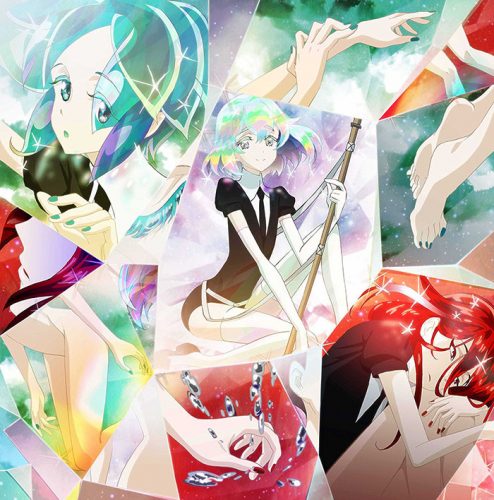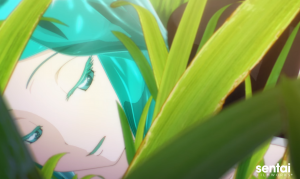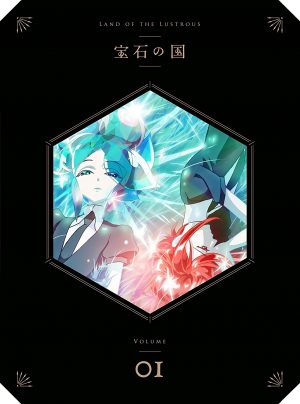
Land of the Lustrous is a popular CG anime that defied expectations. Carefully honing the CG visuals and the variety of its soundtrack, Takahiko Kyogoku (Director) and Yukio Nagasaki (Sound Director) make the show precise and meaningful. With such concise directing, Land of the Lustrous is illuminating in multiple definitions of the word.
Buddhist philosophy is embodied by this show--so much that it transcends its writing, flowing into its cinematography and music. This show is thematically consistent, reflected beautifully through its flowing transitions. Their seamless nature has a distinct message: “death is not the end but a continuation of a journey.”
For this article, we will discuss briefly about the show’s Buddhist visuals and how the skillful use of transitions helps convey the Buddhist idea of reincarnation.
(Writing) Transitions: Life, Death, and Life Again.

To begin, one must first recognize the Buddhist imagery before making a Buddhist interpretation. Luckily, the Buddhist imagery is rather apparent. The minerals such as Phos, Cinnabar, Bort, and etcetera wear a specific dress code for mourning (albeit fashionable): a formal white and black outfit with a collar and tie. The monk that guides them is Kongo-sensei. Just as his students, his dress implies an association: he is a Japanese Buddhist monk that directs funeral rites.
The enemies of the show are the Lunarians, which are beings typically derived from Hindu and Buddhist scripts/artwork. The most common are the Apsaras, or water and air spirits. The Lunarians are an enigmatic race within the story. They arrive to take away the immortal minerals to the moon--this, as far as the minerals know, is permanent separation: death.
In Buddhism, death is not an unchanging state. After all, the idea of reincarnation is shared amongst multiple religions from India, especially Buddhism. For early viewers of the show, separation will seem at odds with the teachings of Buddhism. However, as if anticipating these questions, the Director and Sound Director ease viewers in even before the story explains itself.
(Visual) Transitions: Between Scenes
In film, a transition is a process where scenes or shots are combined after production. Typically, this is done using film/video editing software. The most common type of transition is a cut, and this is simply going from one shot to another, a perspective change.There are numerous types of cuts, each type can influence a scene’s interpretation differently. Great transitions allows ideas to flow better; they connect scenes to better help our understanding.
In Land of the Lustrous, cuts are rarely jarring. What this means is simple: cuts are not confusing. The transitions create a logical segue that viewers can easily follow. When locations jump quickly, the reason for the change is intuitive and logical. This is so consistent across the show, that the transitions prove themselves as methodical and seamless.
For example, in episode 1 when Phos walks to the school, the camera first zooms out from a bell, then pans downward to show the school, Phos, and two minerals watching idly. As Phos walks further, there is a sudden cut to the flowing water. Why, you might ask? Phos explains, “Ah! Gotta make the right impression.” Thus, the show explains its logic.
The camera pans from the water upwards to her fixing her hair, then another cut to her reflection in the water. Why? Again, the answer is intuitive, the water’s reflection allows her to make sure she is presentable. The next question is, “To whom does Phos want to look presentable?” After cutting to dialogue from the idle watchers, there is a sudden scene change. The camera focuses on her face, cuts to a monk (who is he?), and back to her again, perfectly timed to answer our questions, “You called for me, Master Kongo?”
The show anticipates our questions, answering them gracefully with its skillful transitions. When the scene ends, the episode title appears, and a bell chimes, harkening back to the bell focused on earlier. There is an “invisible hand” that guides viewers through the show, explaining itself when you have questions like a gentle teacher.
(Audio) Transitions: Between Music
Land of the Lustrous has astounding sound direction. The proper placement of sound effects and music can influence a scene as much as its visuals. Understanding this, Yukio Nagasaki (Sound Director) bonds the ideas of Yoshiaki Fujisawa (Composer) and Takahiko Kyogoku (Director) with astonishing results.
To begin, Yoshiaki’s music is composed methodically. Certain pieces were created to be in the same key or having similar instruments. Doing this allows for certain songs to transition into another, giving the illusion that they were originally part of the same song.
This is where the Sound Director comes in. Yukio understands the composition’s nuance. Sometimes he shortens a song and uses a section for the emotion it invokes. At other times, Yukio edits the composer’s music, connecting two songs with similar instrumentation, creating a seamless transition between one piece to another.
Thematically, this plays with the same idea in the previous section: seamless transition. To carry this message, the unity of both the music and visuals must work together. Together, they must know how to cut visually on sound, lead into or away from a scene on sound, transition on beat, and construct a message for a scene from its music. This is done so well that Land of the Lustrous could not have a more fitting title.
This unification of both music and visuals carries the message of the writing. Separated, these artforms would be disjointed. Together, however, their message is both powerful and easily understood. These are why the cuts flow so well. They don’t end a scene, they merely begin another. The transitions themselves speak Buddhist philosophy--that death is not the end, but merely the beginning of another journey.
Final Thoughts

The art of transitions is such a subtle one that it can often go unnoticed. Usually, I find this is easier explained visually. However, Land of the Lustrous has gentle and skillful directing. It guides viewers into its thoughtful messages, anticipating questions and guiding one’s eye in a smooth, critical manner. If you have an interest in learning cinematography, Land of the Lustrous is as beautiful to the ear, mind, and eye.
Recommended Post
Houseki no Kuni (Land of the Lustrous) - Fall 2017
Recommended Post



